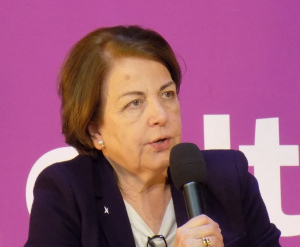Anny-Chantal Levasseur-Regourd, 1945-2022
We are deeply saddened to hear that the astrophysicist and valued member of our community, Anny-Chantal Levasseur-Regourd, has passed away.
Anny-Chantal Levasseur-Regourd pursued her research career at the Service d’Aéronomie (LATMOS institute since 2009) and her teaching as an assistant professor to Jacques Blamont at the Université Pierre et Marie Curie (Paris VI). She was appointed professor of astronomy and space physics in 1985 and became professor emeritus in 2013.
After her studies at the Ecole Normale Supérieure of Cachan, she defended her PhD in Physical Sciences in 1976 under the supervision of Jacques Blamont. She analysed the atmospheric and astronomical observations made by the D2A satellite with a contribution to the study of the zodiacal light. In 1977, she applied to the ESA astronaut selection campaign and was the only woman selected amongst the final participants.
After her PhD, she collaborated with René Dumont on studies of the interplanetary medium and zodiacal light. These observations gave the first global map in intensity and polarisation of the zodiacal light and provided constraints on the local physical properties of the interplanetary dust particles.
Anny-Chantal participated in the international campaign of Halley’s comet return in 1986 both with observations from the ground and as the Principal Investigator (PI) of the OPE experiment on-board the European Giotto spacecraft, which observed the linear polarisation in the inner coma of Halley. Results showed the presence of low-density solid particles and light scattering mostly by large particles. Her work helped define a classification of comets based on their polarization phase curves, a result still discussed in the astronomical community today. She also studied the internal regions of cometary coma by polarimetric imaging.
She continued her work on the study of light scattering by irregular particles by developing facilities in the laboratory and in microgravity (such as PROGRA2, CODAG and ICAPS-LSU) to study simultaneously the intensity and polarization phase curves of aggregating particles under microgravity. A reduced version of the ICAPS experiment will soon fly on-board a TEXUS rocket.

Anny-Chantal’s participation in the Rosetta mission was focused on determining the physical properties of the cometary nucleus and the ejected dust particles. These particles were demonstrated to present fractal structures down to nanometer scales with a composition dominated by organic material. Anny-Chantal was also the PI of the EyeSat student nanosatellite launched by the CNES in 2019. Finally, she actively participated in the development of the EnVisS camera, a multiwavelength polarimetric imager of the ESA Comet Interceptor spacecraft due to be launched in 2029 and dedicated to observing a fresh or interstellar comet.
In summary, Anny-Chantal combined in her work ground-based and space-based observations together with laboratory and numerical simulations to better understand the physical properties of solid dust particles ejected from comets. The object of her studies were mostly linked to the small bodies of the Solar System, comets and asteroids with their similarities and differences, the solid particles they eject, and the interplanetary dust medium that results from their interactions.
She supervised seven PhD students. A dedicated teacher, she never hesitated to motivate her students to give their best, and helped advance their growth as researchers. She pushed forward their work at international conferences and also encouraged them to present their own work. She was particularly enthusiastic about supporting the recognition and advancement of her female colleagues.
Outside of her advising work, she developed numerous national and international collaborations in all the domains of study of the solar system small bodies and light scattering by solid particles which lead to 179 refereed papers (241 conference abstracts).
Anny-Chantal loved to share her passion and she participated in the writing of public outreach books on astronomy (5 books) and to television lectures (for example on canal-U). She delivered numerous public outreach conferences and animations of the astronomical community. She was most notably the President of the French Committee for the organization of the International Year of Astronomy 2009. The asteroid 6170 is named Levasseur in her honor. In recognition of her scientific work, she was appointed Officier de la Légion d’honneur in 2013 and was awarded the following prizes: prix Thorlet de l’Académie des sciences (1976), prix Glaxo de vulgarisation scientifique (1982), prix des Dames de la Société Astronomique de France (1986).
She will be dearly missed by the whole scientific community in France and worldwide.

